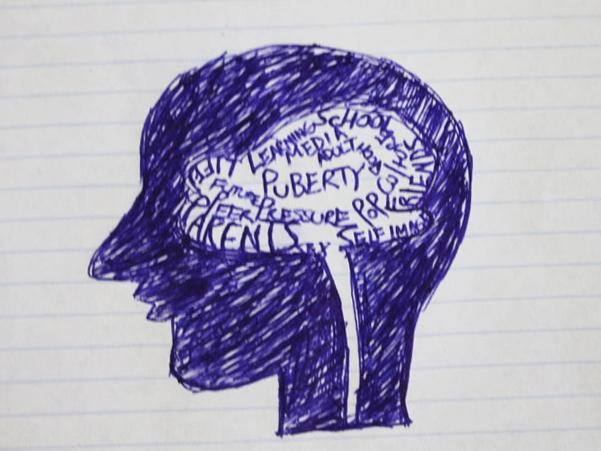Illustration by Logan Monroe
A Look into the Teenage Brain: What’s going on in there?
November 6, 2015
As teenagers, it’s made pretty obvious that we are different from the rest of the world. With high school, puberty and the development of new emotions and ideas, it is typical for teenagers to feel alone and isolated.
Why is this? What does it really mean to be a teenager? And what is actually going on in our heads?
Your body isn’t the only thing growing!
The first big thing that is going on during puberty, according to pbs.org, is the growing of the prefrontal cortex. This is the part of the brain just behind the forehead. It normally focuses on things like planning, memory, organization and mood. This means the more the prefrontal cortex grows, the easier it is for teenagers to have better judgment and control impulses.
The only other time that this part of the brain grows is during infancy, says Sarah Spinks, producer of the PBS documentary Inside the Teenage Brain.
“The fact that this area was still growing surprised the scientists,” says Spinks. “Although they knew that the brain of a baby grew by ‘over synapses,’ or connections, they had not known that there was a second period of over production.”
The brain does this growing by cutting out weaker neurons in order to make way for newer, stronger ones. This is why you often hear high school is the best time to do things like learn a language or play a sport because after this time, the brain finds it harder to take in new information. But this also means that teenagers have to work harder to memorize things, like languages, because if they do not practice every day, the brain will see the information as something it does not need and will cut it out.
Another fact, according to The Society for Science, is that since our prefrontal cortex is still developing, we don’t put as much energy into decision-making. Teenagers do their decision-making in the back of the brain while adults do it in the front. Adult brains are also more wired to notice if something goes wrong in their decision-making.
No work, big reward? Count me in!
One part of the brain that is very well developed during the teenage years is the ventral system. The Society for Science says this is the part of the brain that is built to seek pleasure and reward. In a study, teenage brains were shown to exaggerate when given a medium or large reward. But when presented with a small prize, the brain barely reacted. For example, if your parents told you that you would get a car for cleaning your room, you would be much more likely to clean. But if your parents told you to clean it in exchange for 2 dollars, you probably wouldn’t be in such a rush to get it done.
Why do you really hate everything?
Puberty is a huge time of change for the limbic system. Livescience.com states that, “Part of the limbic system, the amygdala, is thought to connect sensory information to emotional responses. Its development, along with hormonal changes, may give rise to newly intense emotions like rage and aggression, as well as excitement and sexual attraction.”
No one cares.
At around 15 years old, a new feeling pops up in our brains that everyone is watching us. According to Livescience, “While oxytocin is often described as the ‘bonding hormone,’ increased sensitivity to its effects in the limbic system has also been linked to feeling self-consciousness, making an adolescent truly feel like everyone is watching him or her.”
During the teenage years, the brain becomes better at thinking abstractly. Because of this we start to think about what we look like in the eyes of our peers.
“Abstract reasoning makes it possible to consider yourself from the eyes of another,” Livescience says. “Teens may use this new skill to ruminate about what others are thinking of them. In particular, peer approval has been shown to be highly rewarding to the teen brain, which may be why teens are more likely to take risks when other teens are around.”
In simpler terms, it is around this time that we begin to see ourselves in the world. We start to ask ourselves who we want to be, and because of this we become a little bit more self-conscious.
Since approval from our friends and peers is highly rewarding to the teenage brain, this could be why teenagers are more willing to take risks. Friends are also incredibly important to us as they help us learn skills that we need in the real world as adults. Negotiating, compromise and group planning are among the skills we pick up from having a group of friends.
Just want to feel accepted?
Another reason teens take more risks than adults is that teenagers need more danger in order to feel a rush. “The brakes come online later than the accelerator of the brain,” says Livescience.
Let’s wrap this up.
There is no doubt in anyone’s mind that puberty and the teenage years are not easy times in our lives. Puberty is believed to be the second most active time in the human brain next to infancy. The good news is it only lasts for six or so years and then it’s time to smell the roses of adulthood.
